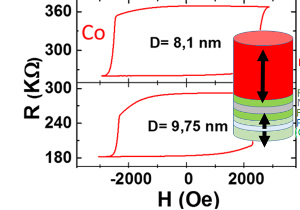Investigation of magnetization dynamics spin transfer torque driven reversal in perpendicular shape anisotropy magnetic tunnel junctions
Spin Transfer Torque Random Access Memories (STTRAM) are focusing an increasing interest in microelectronics industry due to their non-volatility, speed, density, downsize scalability below 20nm nodes, infinite endurance plus radiation hardness. Major microelectronics companies are aiming to introduce STTRAM to provide embedded non-volatile memory.
Recently Perpendicular Shape Anisotropy (PSA) has been demonstrated to provide a breakthrough in the scaling of MRAM cells well below sub-20nm lateral dimensions. This establishes a foreseeable path to extend spin transfer torque (STT) MRAM technology. In a PSA system, the use of a vertically elongated storage layer adds to the stability of the cell. The perpendicular shape anisotropy becomes the major source for stability, contributing on top of the surface anisotropy already used in conventional perpendicular STT-MRAM approaches. To create a PSA system, a ferromagnetic layer thicker than the lateral dimension is deposited on top of an MgO/FeCoB tunnel junction. The conventional CoFeB/MgO interface yields high TMR due to the coherent body centered cubic structure of the MgO tunnel and perpendicular interface anisotropy. Spin torque driven switching has already been shown by applying quasi-static current bias current [1,2]. Estimations of thermal stability factors higher than 300kBT for sub-10nm cells confirm the expected benefit of the PSA approach at these dimensions.
The purpose of this study is to experimentally investigate the magnetization dynamics of spin transfer torque driven reversal in perpendicular shape anisotropy (PSA) magnetic tunnel junctions. This will be achieved by generating a clear physical understanding of the reversal process through the comparison of experimental data and micromagnetic simulations. The study is aimed to provide guidance in the selection of materials and dimensions best suited to achieve performance criteria in PSA memory cells in the sub-20nm design space, especially regarding the consequences and dependencies on the write current-speed trade-off and the thermal stability factor. These junctions will be prepared at SPINTEC.
This work is part of a project funded by Samsung electronics. The initial position is for 1 year and can be extended up to 3 years depending on the work progress and projects results. The applicant should have a good background in magnetism and spin-electronics as well as good experimental skills. The work will be performed within the MRAM team at SPINTEC under supervision of R. Sousa and B. Dieny in collaboration with L. Buda-Prejbeanu.
Applications with detailed CV, letter of motivation and preferably two recommendation letters should be sent by email to Ricardo Sousa (ricardo.sousa@cea.fr) and Bernard Dieny (bernard.dieny@cea.fr).
[1] N. Perrissin et al., “A highly thermally stable sub-20 nm magnetic random-access memory based on perpendicular shape anisotropy,” Nanoscale, vol. 10, no. 25, pp. 12187–12195, Jul. 2018.
[2] K. Watanabe, B. Jinnai, S. Fukami, H. Sato, and H. Ohno, “Shape anisotropy revisited in single-digit nanometer magnetic tunnel junctions,” Nat. Commun., vol. 9, no. 1, Dec. 2018.





